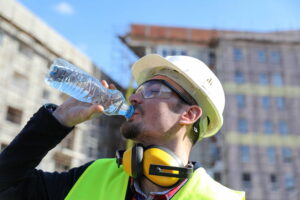 In April 2023, a tragic incident occurred when a farm worker died at a rural property while conducting outdoor labouring work on a scorching hot day.
In April 2023, a tragic incident occurred when a farm worker died at a rural property while conducting outdoor labouring work on a scorching hot day.
Preliminary investigations suggest the worker had complained of cramps, sought shelter and attempted to leave the farm but was later found dead. While these findings are not yet confirmed, they emphasise the importance of understanding and preventing heat-related illnesses in the workplace.
Here are some insights into the risks associated with working in the heat and guidelines to control and manage these risks effectively.
Understanding heat-related illness
Working in the heat can have detrimental effects on a worker's health. The human body strives to maintain a core temperature of around 37 degrees Celsius, and when it struggles to do so, a range of heat-related illnesses can occur. These include heat rash, heat cramps, fainting, dehydration, heat stroke, burns, reduced concentration, increased chemical uptake and an elevated risk of slips and accidents.
Managing health and safety
To ensure worker safety in hot environments, a commitment to health and safety is paramount. Effective risk management, as mandated by the Work Health and Safey Act 2020 (WA) requires a step-by-step approach to eliminating or reducing hazards through the hierarchy of controls. Eliminating the hazard remains the most effective control.
Possible control measures
Identifying the risks:
Risks associated with heat-related illnesses are influenced by several factors, including workplace conditions, job requirements and individual worker attributes. Consider factors such as exposure to sunlight, air movement, clothing, personal protective equipment, physical exertion, hydration, access to cool rest areas, acclimatisation, worker fitness, medical conditions and geographical location.
Controlling the risks:
- Modifying the environment:
- Control the source of heat by reducing its temperature or insulating hot surfaces.
- Use radiant heat shields, shade barriers, and ventilation systems to cool the work area.
- Employ artificial cooling devices such as evaporative coolers or air conditioning.
2. Modifying the work:
- Utilise mechanical aids to reduce physical workload.
- Plan work indoors or in shaded areas.
- Provide rest areas and refuges for workers to cool off.
- Implement administrative controls such as worker selection, scheduling and work-rest intervals.
Personal protective equipment (PPE):
- Choose PPE that minimises heat strain, including protective clothing made from natural fibres and lightweight undergarments.
- Consider specialised cooled or conditioned PPE, such as air or liquid circulating systems.
Training:
- Train workers to recognise heat exposure, predisposing factors and the importance of fluid intake.
- Emphasise the effects of acclimatisation and the recognition of heat illness symptoms.
Preventing heat-related illnesses is crucial in maintaining worker safety, particularly in hot environments. By identifying and controlling the risks, modifying the environment and work processes, and providing adequate training and PPE, employers can significantly reduce the likelihood of heat-related incidents. Regularly reviewing and adapting control measures will ensure a safe and healthy work environment.
Our qualified Workplace Health and Safety experts provide cost-effective solutions to manage your WHS needs, reduce the risk to your workers and help you meet WA’s WHS laws. Email [email protected] or call (08) 9365 7746.



